Jewish Women in Novels by Early Jewish Female Writers
By Francis Booth | On December 24, 2021 | Updated January 28, 2025 | Comments (2)
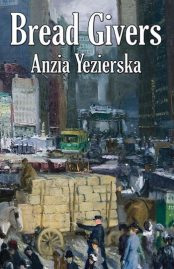
Depictions of Jewish women in fiction or memoir by Jewish female writers prior to the late 19th century and the first decades of the 20th were rare, whether in English or translation were rare gems.
Even if the works discussed ahead weren’t the most brilliant by the highest of literary standards, all are eminently readable, and completely fascinating —that is, if you’re lucky enough to find them.
Working back from Vera Caspary’s Thicker Than Water (1932) to Amy Levy’s controversial Reuben Sachs (1888), these often autobiographical novels offer gritty, realistic portraits of Jewish family and romantic life of their times.
Excerpted from the forthcoming book A Girl Named Vera Can Never Tell a Lie: The Novels of Vera Caspary by Francis Booth, reprinted with permission.
. . . . . . . . . .
Thicker Than Water by Vera Caspary (1932)
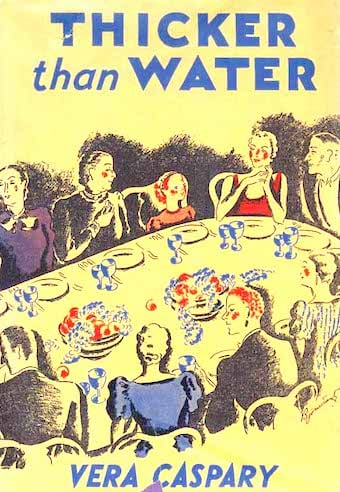
Vera Caspary’s Thicker Than Water (1932) is unlike any other of her novels: it is a family saga spanning forty-six years, starting in the 19th century and bringing us right up to date at the end of the 1920s twenties flapper era with no concern for tradition or history, only for the present. Caspary made it clear that the family in this story is her own family.
Out of memories awakened in Mama by my descriptions of the sister she had not seen for so many years came the notion of a novel. This was another novel I had to write. Nothing could keep me from it, neither fear nor practical considerations nor intimations of future gutters. I wrote as I had always wanted, completely absorbed in a tale of my mother’s generation, my sister’s girlhood and my own time, a novel that recorded the passing of forty-six years in a family; my family disguised, dramatized, but essentially the Casparys.
Caspary herself was a thoroughly modern working woman, earning unheard of sums of money for a woman her age. Unencumbered by family, religion, or husband, she traveled the world writing. As the review of Thicker Than Water in the New York Times said:
Writing is not necessarily a sedentary occupation – not when Vera Caspary is the writer. A new book, Thicker Than Water, announced for immediate publication by Liveright Inc., was started in Great Neck and continued on the boat en route to England.
The first few chapters were thrown away in London, and the author started all over again in Paris. She continued writing on the boat coming back to the United States, finished the book in New York, corrected it in Chicago and proofread it in Brookfield, Conn.
The central character at the start of Thicker Than Water is Rosalia, the name of Caspary’s grandmother’s sister and an anagram of Solaria, the central character of Caspary’s first novel The White Girl. She herself is a modern woman by the standards of the end of the 19th century and has no wish to find a husband.
However, her younger brother wants to marry, and by family and social tradition, he cannot do so until his elder sister is married. Rosalia isn’t considered attractive, is rather old for the marriage market, and has very little money – she was adopted by her uncle when her father lost his fortune.
She settles for a Jewish man of German extraction, despite her family – like Caspary’s family – looking down on any Jewish families not of Spanish or Portuguese descent. As Caspary wrote in her autobiography,
Indifferent though we were to religion, we were contemptuous of Jews who denied being Jewish or changed their names and contradicted ourselves with scorn for those whose names ended in -witz or -ski. Papa’s sister, my beloved Aunt Olga, the most merciful of women, would often tell me in a hushed voice, “They’re not the finest kind of Jewish people, dear.”
Rosalia’s husband takes a mistress. And then another. He buys Rosalia a house, where she feels stuck with her daughter, unable to fulfill all the dreams she had, most of which came from books. As the years go on, her daughter Beatrice leaves home and then leaves her husband; she goes off on her own to make a fortune in business which she then loses in the 1929 Wall Street crash.
And then there is a granddaughter called Rosalie, or Little Rosie, who marries an impecunious artist. In a gesture of reconciliation with both her granddaughter and the modern world, Rosalia gives Rosie a family heirloom which she has guarded zealously a whole life.
. . . . . . . . . .
I Am a Woman — and a Jew by Leah Morton (1926)
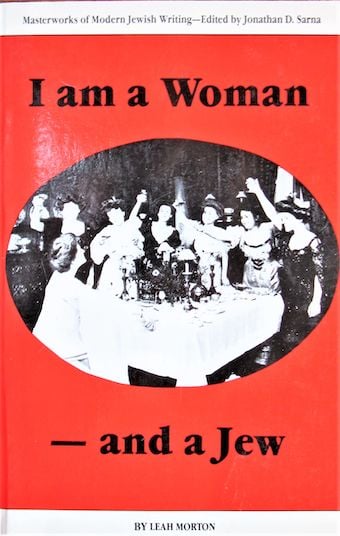
I Am a Woman – and a Jew (1926) is an autobiographical novel by Leah Morton (1889 – 1954; born Elizabeth Gertrude Levin) repeats this idea of the superiority of Spanish and Portuguese descent and promotes the idea that there is an ancient Jewish race memory:
… we Jews are alike. We have the same … sensitiveness, poetry, bitterness, sorrow, the same humor, the same memories. The memories are not those we can bring forth from our minds: they are centuries old and are written in our features, in the cells of our brains.
Morton combines this idea with the anti-Polish racism of her family, identical to the racism of the Piera family in Thicker Than Water, although Morton herself was born in Poland.
I, very tall for my age, very thin, with enormous brown eyes, and excessively high forehead that we all thought the acme of homeliness, and a funny nose that had neither the exquisite delicate curve of Hannah’s, nor the round impudence of Simeon’s, but was only a sort of parody of the Polish noses servants had.
They called me the “Polak,” because I was quick and vivid, dreamy and intense, and sometimes obstinate as a stupid Polish servant who will not see what her bettors tell her. When my father said quietly, “Do thus,” and I asked, “Why?” he would look at me with his deep glance and reply, conclusively, “Do not be a little Polak.”
. . . . . . . . . .
Red Damask by Emanie Sachs (1927)
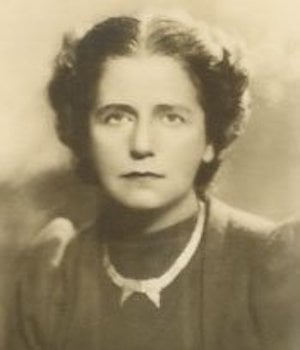
Like I Am a Woman – and a Jew and Thicker Than Water, Red Damask by Emanie Sachs concerns a young woman, Abby Hahl, from a proud New York Jewish facing intra-Jewish prejudices as she looks for a suitable husband. Her family also place Jews of Portuguese descent in a higher class than all the others, at the apex of pyramid of prejudice.
German Jews avoided Polish and Russian Jews, whose struggle for mere existence in persecutory countries had forced them to develop shrewdness without ethics. They were unfair competitors for the ethical Germans, who always obeyed the letter and sometimes the spirit of the law. So the Germans detested the timeless craftiness, which had no restraints and called them Polacks and Kikes and excluded them from the charity boards, the social and financial indexes of New York Jewry.
In the past the more leisurely, cultured Portuguese had tried to exclude the German Jews, whose dogged industry had menaced and reduced their power. The Portuguese Jews, absorbed into Gentile groups or dead, had vanished as a force in the community . . . The German is now feared the Russians and the Poles, though they did not call it fear.
Sachs wasn’t prolific, but she was versatile. She wrote a biography of the infamous free-love advocate Victoria Woodhull, The Terrible Siren (1928); the novels Talk (1924), about a woman who “seemed too progressive for owning and running a bookstore after she became married”
She also wrote the proto-psycho-thriller The Octangle: An Unconventional Murder Story (1928): The story of a murder in which a group of eight people are involved. The interest lies more in their psychology and in their history than in the identity of the murderer because it is their personalities as well as events in their lives which have led to the crime and to the effects of it afterwards.”
. . . . . . . . . .
Salome of the Tenements (1922) and Bread Givers (1925)
by Anzia Yezierska

Anzia Yezierska was one of the precursors to Caspary’s saga of Jewish family life, Thicker Than Water. Like Caspary, but unlike most traditional Jewish writers, Yezierska put women at the center of her writing— those born into poverty-stricken Jewish families in New York’s Lower East side. Her stories were first collected in Hungry Hearts, 1920, and made into a silent movie in 1922.
Bread Givers (1925) remains Yezierska’s best-known works. The novel depicts the struggle of Sara Smolinsky and her three sisters with their orthodox father, a Torah scholar who refuses to work. He therefore earns no money and tries to force his daughters to marry against their will so they can support him.
Fortuitously, Sara wins a thousand dollars in an essay competition at her college and becomes a teacher, escaping from her slum background and the tyranny of her father, “the tyranny with which he tried to crush me as a child,” and comes of age as an independent single woman in America.
A triumphant sense of power filled me. Life was all before me because my work was before me. I, Sara Smolinsky, had done what I had set out to do. I was now a teacher in the public schools. And this was but the first step in the ladder of my new life. I was only at the beginning of things. The world outside was so big and vast. Now I’ll have the leisure and the quiet to go on and on, higher and higher.
Once I had been elated at the thought that a man had wanted me. How much more thrilling to feel that I had made my work wanted! This was the honeymoon of my career!
In Yezierska’s Salome of the Tenements (1922) Sonya Vrunsky is another poor but strong-minded, independent Jewish woman, another creation worthy of Caspary herself.
The title of the novel is a reference to the biblical Salome, who made her stepfather cut off the head of John the Baptist for her. In the New Testament gospels of Mark and Matthew however, it is her mother who makes Salome ask for the severed head.
A woman should be youth and fire and madness — the desire that reaches for the stars. A man should be wisdom, maturity, poise. (Anzia Yezierska, Salome of the Tenements)
Sonya Vrunsky decides she is going to escape poverty by marrying an “Anglo-Saxon” millionaire. She does, though in the end she decides he is not for her, goes off with someone else and carves out a career for herself as a fashion designer.
Manning, the millionaire husband, having previously always been “fastidiously aloof,” unravels when he realizes that Sonya has been deceiving him; this is her coming-of-age moment both as a woman and as a Jewish woman.
Dazed, struck into sudden awakening by her repulse, his burning gaze covered her from head to foot. Hair disheveled, waist torn away, revealing the heaving bosom, the white throbbing neck, she stood there, superb, ravishing in her fury … Her scorn stripped him naked, exposed him to himself.
“So this is Manning, the Anglo-Saxon gentleman, the saint, the philanthropist – the savior of humanity.”
Wonder was in her eyes and cold anger in her voice.
“You didn’t want me when I was burning for you,” she laughed harshly, remembering how she had lain beside him night after night, sleepless, nerves unstrung, hungering in vain for a kiss, for a breath of response, for a sign of his need of her. “Now I don’t want you.”
In the triumph of her sex which he had once so cruelly mortified she looked fully at him. This was her moment. She had it in her to bring this wreck back to life – to give him the warmth, the passion, the ardor that none of the women of his kind could give. There he stood perishing for her. . . Here was a child that needed comforting. And she was a woman. For the first time in all her life she was a woman.
. . . . . . . . . .
Reuben Sachs by Amy Levy (1888)
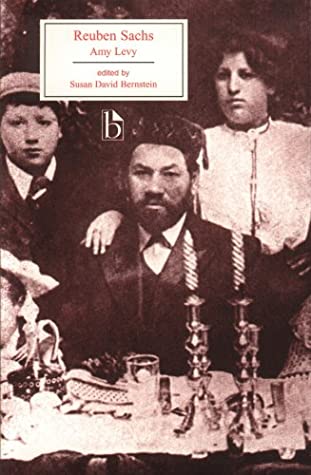
Closer to Caspary’s fictional family in social standing if not in geography are the wealthy Sachs family in Reuben Sachs (1888) by Amy Levy (1861 – 1889). Levy, a British novelist and feminist essayist, was the first Jewish woman at Cambridge University, Levy lived the life of the “New Woman” with a circle of literary and sometimes lesbian friends, especially her probable lover Vernon Lee.
The Sachs family lives in the most prestigious parts of London, England (Levy’s own parents lived in Bloomsbury). The Sachs are “a family of Portuguese merchants, the vieille noblesse of the Jewish community.” Both Caspary’s real family and her fictional family in Thicker Than Water share this pride in their ancient Portuguese heritage, especially compared to more recent German and Polish Jewish immigrants, on whom they look down.
In the Sachses’ London Jewish community, “with its innumerable trivial class differences, its sets within sets, its fine-drawn distinctions of caste, utterly incomprehensible to an outsider, they held a good, though not the best position.”
This short novel was written in response to what she considered the over-sentimental treatment of the Jewish characters and what she considered the naïve, romantic view of Zionism in George Eliot’s Daniel Deronda (1876) with its “little group of enthusiasts, with their yearnings after the Holy Land.”
Despite the man’s name in the title of Levy’s Reuben Sachs, the novel is at least as much about Reuben’s cousin Judith Quixano, a Caspary woman in the making, similar in some ways to Rosalia, her counterpart in Thicker Than Water and to Solaria in The White Girl. Judith’s patrician Portuguese ancestry is revealed in this description of her:
She was twenty-two years of age, in the very prime of her youth and beauty; a tall, regal-looking creature, with an exquisite dark head, features like those of a face cut on gem or cameo, and wonderful, lustrous, mournful eyes, entirely out of keeping with the accepted characteristics of their owner.
Judith (whose name references the Biblical story of Judith and Holofernes), who has been adopted by her aunt and uncle after her family lose their money, doesn’t have a financial inheritance of her own and, despite her good looks, she knows her adoptive parents will find it difficult to marry her off into another good Jewish family.
Judith is in love with Rueben and vice versa, although they are first cousins. It looks for a while as if they will marry, but Judith receives a marriage proposal from the non-Jewish, wealthy Bertie. She reluctantly accepts. Judith regrets her decision almost immediately and wishes she had held out for Reuben. Then she hears that Rueben has died. The novel ends on a low note, with Judith’s dark thoughts.
Although it was a commercial success on both sides of the Atlantic, the British Jewish press hated Reuben Sachs, with its merciless portrayal of such shallow, unsympathetic characters. Jewish World said of Levy: “She apparently delights in the task of persuading the general public that her own kith and kin are the most hideous types of vulgarity.”
The Jewish Chronicle didn’t even review it, despite having published Levy’s earlier essay, but referred to it as being “intentionally offensive.”
Levy took her own life at the age of twenty-seven and became the first Jewish woman to be cremated in England; Oscar Wilde, who had published her stories in his Woman’s World, wrote an obituary for her. Learn more about Reuben Sachs.
. . . . . . . . .
Contributed by Francis Booth, the author of several books on twentieth-century culture:
Amongst Those Left: The British Experimental Novel 1940-1960 (published by Dalkey Archive); Everybody I Can Think of Ever: Meetings That Made the Avant-Garde; Girls in Bloom: Coming of Age in the Mid-Twentieth Century Woman’s Novel; Text Acts: Twentieth-Century Literary Eroticism; and Comrades in Art: Revolutionary Art in America 1926-1938.
Francis has also published several novels: The Code 17 series, set in the Swinging London of the 1960s and featuring aristocratic spy Lady Laura Summers; Young adult fantasy series The Watchers; and Young adult fantasy novel Mirror Mirror. Francis lives on the South Coast of England.
Thank you!
I have just joined a Jewish Book Club. Since everyone is asked to speak about a book special to them, I thought I should find a female Jewish author. Suddenly realising how little reading I have done of this Genre. I very much enjoyed this collection of articles. Though I am still wondering where to start! I am 61 years old. A convert to the Jewish faith. Any suggestions would be much appreciated.
Tzipporah, thank you for your comment. This is a really niche collection of early 20th century Jewish women writers; but there are others from midcentury that would be fascinating to explore. Vera Caspary was a prolific author in the romantic thriller and noire genre; several of her books were made into films (she’s kind of forgotten). Her most famous is Laura (https://www.literaryladiesguide.com/literary-analyses/the-ultimate-caspary-woman-laura-by-vera-caspary/) which was made into a famous noir film.
Then there is Edna Ferber (https://www.literaryladiesguide.com/author-biography/edna-ferber/) — see her book list at the end of the post. Many of her books were also made into films. She managed to work social justice themes into many of her sweeping sagas, like Showboat (https://www.literaryladiesguide.com/film-adaptations-of-classic-novels/edna-ferbers-showboat-from-stage-to-screen/).
Anita Brookner was Jewish (https://www.literaryladiesguide.com/author-biography/anita-brookner-author-of-hotel-du-lac/) as was Clarice Lispector (https://www.literaryladiesguide.com/author-biography/clarice-lispector-brazilian-novelist-and-journalist/). I hope this helps!